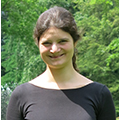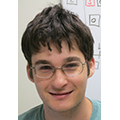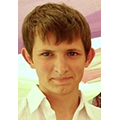Student Poster Abstracts
 Victor Chardès Ecole Normale Superieure v.chardes@gmail.com |
Optimal response to pathogen evolution in immune repertoiresIn order to target threatening pathogens, the adaptive immune system performs a continuous reorganisation of its immune cell repertoire constrained on the antigenic load. This emergent self-organised repertoire results from a variety of biological processes such as affinity maturation or thymic selection. Previous work formulated an effective theory predicting immune repertoire organisation, assuming that it results from an optimization problem with biological constraints. Here we extend this formalism to a co-evolutionary setting, where we explicitely consider the effects of a continuously mutating viral population and immune cell maturation processes on the dynamics of immune repertoire adaptation. |
|
 Xiaowen Chen Princeton University xiaowenc@princeton.edu |
Exploring the energy landscape of C. elegans neural activitiesRecent advances in experimental techniques and application of the maximum entropy principle have allowed us to build models for joint probability distribution of activity in groups of up to 50 neurons in Caenorhabditis elegans, a nematode with 302 neurons. These models, which are equivalent to the Boltzmann distribution for a family of Potts glasses, successfully predict the static observables of the network. The energy landscape defined by these models exhibits curious signatures of collective behavior, including a large number of energy minima, as in models for memory, and a clustering of energy barriers that is reminiscent of the dynamical transitions in disordered systems. While these models describe the distribution of network states at a single time, the observed neural dynamics are not consistent with a simple Brownian-like motion on the energy landscape. In particular, the real dynamics exhibit much longer correlation times than predicted from the heights of energy barriers alone. We will show progress towards understanding how the nematode actually explores the energy landscape of its neural network. |
|
 Sang Hyun Choi University of Illinois, Urbana-Champaign schoi109@illinois.edu |
Power-law interaction time distribution for barcoded honeybees in a hiveCommunities are not simple collection of individuals. Self-organization of individuals gives rise to network structures responsible for dynamics within communities. Compared with inter-event time distribution, which is associated with burstiness found in networks, event duration distribution has been of less focus in the study of social networks. In this work, we measured the duration of trophallaxis, or mouth-to-mouth liquid food transfer, of barcoded honeybees in a hive by using an automated monitoring method with high spatiotemporal resolution. This interaction duration distribution is observed to follow a power-law as in human face-to-face interaction. We derive this power-law by viewing the bond between bees as a particle escaping over a distribution of energy barriers. Different barrier heights represent heterogeneity in the population. Exponent in the power-law is related to the exponent in the barrier height distribution. The theory predicts that, without heterogeneity in the population, the interaction duration distribution would be exponential, which is verified to be a sum of exponentials by pair-interaction analysis. Single-bee analysis suggests that, while each individual bee is not much different from each other, how each pair interacts is different, from which the heterogeneity in the population arises. Our work shows that despite the apparent complexity of social interactions, simple and universal behavior can emerge from the collective dynamics, whose observation and analysis are enabled by the recent development of high-resolution detection and tracking technology. |
|
 Wenping Cui Boston College wenpingcui@gmail.com |
Diverse communities behave like typical random ecosystemsWith a brief letter to Nature in 1972, Robert May triggered a worldwide research program in theoretical ecology and complex systems that continues to this day. Building on powerful mathematical results about large random matrices, he argued that systems with sufficiently large numbers of interacting components are generically unstable. In the ecological context, May’s thesis directly contradicted the longstanding ecological intuition that diversity promotes stability. In economics and finance, May’s work helped to consolidate growing concerns about the fragility of an increasingly interconnected global marketplace. In this Letter, we draw on recent theoretical progress in random matrix theory and statistical physics to fundamentally extend and reinterpret May’s theorem. We confirm that a wide range of ecological models become unstable at the point predicted by May, even when the models do not strictly follow his assumptions. Surprisingly, increasing the interaction strength or diversity beyond the May threshold results in a reorganization of the ecosystem–through extinction of a fixed fraction of species–into a new stable state whose properties are well described by purely random interactions. This self-organized state remains stable for arbitrarily large ecosystem and suggests a new interpretation of May’s original conclusions: when interacting complex systems with many components become sufficiently large, they will generically undergo a transition to a “typical” self-organized, stable state. |
|
 Luca Di Carlo University Rome-La Sapienza luca.dicarlo94@gmail.com |
Dynamic Renormalization Group approach to collective behavior in animal groupsWhile flocks resemble a system in a deep ferromagnetic phase, experimental evidences suggest that swarms of insects are at criticality, the critical point is characterized by diverging correlation length (long range correlations) and relaxation time (critical slowing down). It is possible to build a model, namely the Inertial Spin Model (ISM), capable of describing both the swarm phase and the flock phase. We studied critical properties of the equilibrium-ISM, which is the on lattice version of the ISM, using Dynamic Renormalization Group, and compared our theoretical results with both numerical simulations and experimental data on swarms of midges. Particularly we computed the dynamical exponent linking correlation length and relaxation time. At one loop in perturbation theory, we found a cross over form an IR-instable fixed point with z=d/2 and an IR-stable fixed point with z=2; the crossover length scale is determined by the ratio between the dissipation coefficient and the friction of the spin, this ratio is believed to be large for biological reasons, hence in real finite size systems is only possible to observe the IR instable fixed point. Theoretical prediction are completely confirmed by numerical simulations. However the measured value form the experimental data is z = 1. We studied the on lattice version of the model, hence it is not surprising that the predicted value of z is different from the measured one. Anyway we point out that the value z=3/2 is significantly lower the the standard value z=2, typical of the Vicsek universality class. |
|
 Veronika Dubinkina University of Illinois, Urbana-Champaign vd6@illinois.edu |
Alternative stable states in a model of microbial community limited by multiple essential nutrientsMicrobial communities routinely have several alternative stable states observed for the same environmental parameters. Transitions between such alternative stable states could be sudden and irreversible making external manipulation of these systems more complicated. Can we predict which specific perturbations may induce such regime shifts and which ones would have only a transient effect? To study this topic we introduce a model of a microbial ecosystem colonized by a large number of specialist species. Growth of each of the species can be limited by essential nutrients of two types, e.g. carbon and nitrogen, each represented in the environment by multiple metabolites. We demonstrate that our model has an exponentially large number of potential stable states realized for different environmental parameters. Using game theoretical methods adapted from the stable marriage problem we predict all of these states based only on ranked lists of competitive abilities of species for each of the nutrients. We show that for every set of nutrient influxes, several mutually uninvadable stable states are generally feasible and we distinguish them based upon their dynamic stability. We further explore an intricate network of discontinuous transitions (regime shifts) between these alternative states both in the course of community assembly, or upon changes of nutrient influxes. |
|
 Federica Ferretti University Rome-La Sapienza f.ferretti@uniroma1.it |
Statistical Inference approach for the Kramers problem and application to flocksKramers processes provide an effective description for many problems, ranging from chemical physics to communication theory. Despite their wide use, we don’t know of any statistical inference strategy already designed for this class of processes, probably because of the technical difficulties arising from its peculiar structure, namely the singularity of the diffusion matrix. Here these technical aspects are briefly discussed in order to explain the shortcomings of a straightforward naive approach (shown in the case study of the Inertial Spin Model for active flocks), and possible ways out are proposed. |
|
 Athos Fiori University of Basel athos.fiori@unibas.ch |
Microbial population in fluctuating environments, how the size influences the strategyThe survival of organisms in randomly fluctuating environments not only depends on their ability to grow in different nutrients conditions but also depends on the time needed to adapt to the new habitat. Recent work has shown that, like many other physiological quantities, the adaptation time fluctuates in a stochastic manner across single cells and that the underlying distribution can dramatically change across genotypes. To understand how natural selection may have acted in order to shape such distribution we develop a mathematical theory on how the reproductive success of iso-genic populations depends on their lag time distribution and initial population size. Our model suggests that in general large populations favor the so-called “bet-hedging” strategy where, by phenotype randomization, subsets of the total population are adapted to different environment types. In this scenario the first responding organisms will dominate the offspring structure and, in analogy with the theory of aging, we show why natural selection is insensitive to slow responding cells suggesting that persister like phenotype may very generally be expected to occur in microbial population. These results strictly depend on the characteristic population size and we show how a sensing mechanism, where by sensing the environment and switching to the right phenotype, becomes a more efficient strategy when the colony size becomes relatively small. |
|
 Solange Flatt Swiss Fed Inst Tech-Lausanne solange.flatt@epfl.ch |
Thermodynamics of substrate transfer in ABC transporters seen in the framework of Maxwell's DemonThe ATP-binding cassette transporters (ABC transporters) form one of the largest families of transmembrane transporters that take part in a broad range of biological processes. The structural characterization of the different conformations reached by the protein during the transport cycle is well known. However, the transformation of energy carried by ATP hydrolysis into a substrate chemical potential difference is still unknown. The question that guides the current research is the identification of the optimal parameters, in term of binding time scales and hydrolysis rate to improve the efficiency of the transport mechanism, that is an importer or an exporter. We will discuss how the energy consumption aims to keep the ABC transporter in a non-equilibrium state and also may improve the optimality of the process. The model used to address this problem is inspired from the Maxwell’s Demon thought experiment, which brings the combined notions of measure, feedback and action in the model of ABC transporter. We foresee that the analytical and numerical resolutions of our model will shed some light on the working of ABC transporters as well as on the role of energy consumption crucial to this process. |
|
 Eliott Flaum Stanford University eflaum@stanford.edu |
Mechanics of behavior: Comprehensive search behavior encoded in cytoskeletal dynamics of single cell Lacrymaria olorE.M. Flaum1,2, S.M. Coyle2, B.M. Benson1,3, D. Krishnamurthy1,4, M. Prakash1,5,6 1Bioengineering, Stanford University, 2Graduate Program in Biophysics, Stanford University, 3Applied Physics, Stanford University, 4Mechanical Engineering, Stanford University, 5Faculty Scholar, Howard Hughes Medical Institute, 6Investigator, Chan Zuckerberg BioHub Complex animal behavior arises from interplay between actuators (muscles), sensors (proprioception, vision) and control (neuronal circuits). Surprisingly, single eukaryotic cells such as protists are also capable of complex real-time animal like behavior, such as escape or hunting with actuation, sensing and control embedded in a single cell. How a complex algorithm such as search behavior might be encoded in intrinsic dynamics of a single cell remains unknown. Here we elucidate the mechanics of search behavior in a predatory ciliate Lacrymaria olor. Remarkably L.olor has the ability to extend and contract its “neck” seven body lengths in a second, while it efficiently searches the space around it for prey on the order of minutes. Our recent work establishes that L. olor’s comprehensive search strategy while hunting is encoded in the coupling of antagonistic active systems: subcellular structures that use surface cilia and cortical cytoskeletal contractility (Coyle et al, 2018). Here we reveal the underlying geometrical features of the cellular cytoskeleton that enables rapid extension and contraction. These large morphological changes in cell shape are bounded by several membrane and cell volume constraints that together program the dynamics of this active filament. By performing force spectroscopy and controlled membrane tension experiments in live cells, we reveal the role of this dynamic force landscape and how it shapes the search phase space. Our work combines theoretical active filament models with experimental data to unravel how active mechanics leads to emergent behavior in single cells. |
|
 Ezequiel Alejandro Galpern University of Buenos Aires eagalpern@gmail.com |
Size and structure of the sequence space of repeat proteinsJacopo Marchi , Ezequiel A. Galpern , Rocio Espada , Diego U. Ferreiro, Aleksandra M. Walczak , Thierry Mora The coding space of protein sequences is shaped by evolutionary constraints set by requirements of function and stability. We show that the coding space of a given protein family —the total number of sequences in that family— can be estimated using models of maximum entropy trained on multiple sequence alignments of naturally occuring amino acid sequences. We analyzed and calculated the size of three abundant repeat proteins families, whose members are large proteins made of many repetitions of conserved portions of ∼ 30 amino acids. While amino acid conservation at each position of the alignment explains most of the reduction of diversity relative to completely random sequences, we found that correlations between amino acid usage at different positions significantly impact that diversity. We quantified the impact of different types of correlations, functional and evolutionary, on sequence diversity. Analysis of the detailed structure of the coding space of the families revealed a rugged landscape, with many local energy minima of varying sizes with a hierarchical structure, reminiscent of fustrated energy landscapes of spin glass in physics. This clustered structure indicates a multiplicity of subtypes within each family, and suggests new strategies for protein design. |
|
 Ireth Garcia Aguilar Leiden University / Sea garcia-aguilar@lorentz.leidenuniv.nl |
Screening of topological defects in 2D crystals: the role of dislocations and curvature.Two-dimensional crystallization on curved surfaces is the subject of ongoing research across different length scales. The hexagonal lattice is the most efficient 2D close packing structure for particles with isotropic interactions. Such crystals are therefore commonly found in various physical systems, where they adopt different shapes. While flat space can be perfectly tiled with an hexagonal lattice, crystals on closed surfaces, like the sphere, are topologically constrained to accommodate at least some defects, even at zero temperature and regardless of their size. These point defects are called disclinations and they are sources of great mechanical stress. The stress induced locally can be partially relieved by the intrinsic curvature of the crystal but, interestingly, also by the spontaneous formation of additional defect lines, referred to as dislocations scars. In this poster, we investigate curvature and dislocation scars as screening mechanisms of disclination stress. We find that their interplay can greatly influence the crystal shape and size-dependent properties. In the context of our continuum model for elasticity of closed crystals, we discuss the behaviour of the crystal energy with the scar density and crystal size. Our model leads to a defined expression of the elastic energy of any closed crystal, as a function of its size. |
|
 Georgios Gounaris University of Pennsylvania gounaris@sas.upenn.edu |
Distribution efficiency and structure of complex networks.Optimized transport networks play a key role in the function of various artificial and natural systems, such as plant or animal vasculature. Part of the function of these flow networks is to efficiently distribute nutrients to the organism. In the case of the animal circulatory system, the oxygen distributed to the tissues is carried by the red blood cells flowing through the capillaries in the blood plasma. The architecture of the network, as defined by its structure and topology controls both the energy dissipated in transferring the viscous fluid (e.g. the blood through the capillaries) and the efficiency of the nutrient transport (e.g. how the oxygen is distributed in the tissue). In this work, we investigate the optimal structure of networks when both energy optimization and transport efficiency are considered. We discuss how the |
|
 Caroline Holmes Princeton University cholmes@princeton.edu |
Stochastic architectures in the retinaA significant amount of work has been done on the surprising level of developmental precision in biology. However, development is not precise in many cases – especially among larger organisms, it seems that instead of attempting to recreate a very precise pattern, the aim of development is to fall within some class of architectures which are similar in some functional sense, but highly variable at the cell-to-cell level. There are many examples of this, including the dramatically different numbers of neurons found in different brain areas among humans. Another example is the retina, where the placement of photoreceptors is nearly crystalline for some organisms, such as flies, but is much closer to randomly placed for others, such as humans. We investigate this, and attempt to understand the regimes where a perfectly precise solution is required, and where a more stochastic solution is sufficient. |
|
 Michael Hunter University of Cambridge michael.hunter26@hotmail.co.uk |
Evolutionary Dynamics of Phage Populations Undergoing a Spatial Range ExpansionSpatially growing populations are ubiquitous in nature. Unlike the case of ‘well-mixed’ scenarios, individuals in a population undergoing a spatial range expansion experience different conditions dependent on their position. In this case, individuals near the expansion front benefit from access to new territory, while affording the same benefit to their progeny. Expansions such as these generally fall into two classes. The first class describes expansion waves which are pulled forward by the dynamics at the leading edge of the expansion, and are very susceptible to genetic fluctuations. The second class describes waves which are pushed forward by the dynamics behind the front, and are more robust to fluctuations. In my PhD, I am investigating the evolutionary dynamics of a particular type of spatially expanding population: plaque-forming bacteriophage in E.coli lawns. Existing efforts to describe plaque growth generally employ a linearized reaction-diffusion equation to predict observable properties such as front velocities. The extent of genetic diversity at the front of the plaque is, however, still unknown and not explicitly addressed by current theory of plaque formation. Here, I show that phage exhibits non-uniform dispersal, which can trigger the transition from a pulled to a pushed wave. The consequences of this effect on the adaptation potential of the virus are discussed. |
|
 Giulio Isacchini Max Planck Institute for Dynamics and Self-organization giulio.isacchini@ds.mpg.de |
Statistical Physics Modelling and Information Processing in the Adaptive Immune SystemAdaptive immunity in vertebrates develops during the life-time of an organism by processes of mutation and selection, common to Darwinian evolution. Pathogens adopt different molecular strategies to overcome the immune challenge. For chronic infections, the battle against the immune system lasts for years within a patient, e.g., 10-15 years for HIV. During this time, the symptoms are minor, but viral and immune cell populations undergo rapid sequence turnover to overcome the challenge imposed by the other, forming a co-evolutionary arms race. Recently, sequencing an entire antibody repertoire has become feasible, opening a new path for quantitative understanding of this system. Statistical inference on such data together with mechanistic and phenomenological modelling have taught us a great deal about the space of the immune interaction that can distinguish between self-molecules (proteins of the host) and non-self infecting pathogens. However, we still lack a statistical understanding of how predictable an immune response may be against evolving pathogens, and thus, how controllable it is by external interventions (e.g. vaccination or drugs). The objective of my research is to use statistical learning methods combined with machine learning approaches to develop predictive models of immune repertoire response. |
|
 Alexander Klug University of Cologne klug@thp.uni-koeln.de |
Recombination and mutational robustness in fitness landscapesTwo long-standing and seemingly unrelated puzzles in evolutionary biology concern the ubiquity of sexual reproduction and the robustness of organisms against genetic perturbations. Using a theoretical approach based on the concept of a fitness landscape, we argue that the two phenomena may in fact be closely related. In our setting the hereditary information of an organism is encoded in its genotype, which determines it to be either viable or non-viable, and robustness is defined as the fraction of mutations that maintain viability. Previous work has demonstrated that the purging of non-viable genotypes from the population by natural selection leads to a moderate increase in robustness. We show that genetic recombination acting in combination with selection massively enhances this effect, an observation that is largely independent of how genotypes are connected by mutations. This suggests that the increase of robustness may be a major driver underlying the evolution of sexual recombination and other forms of genetic exchange throughout the living world. |
|
 Isabella Kraemer Ludwig Maximilian University Munich isabella.r.graf@physik.uni-muenchen.de |
Stochastic Yield Catastrophes and Robustness in Self-AssemblyA guiding principle in self-assembly is that, for high production yield, nucleation of structures must be significantly slower than their growth. However, details of the mechanism that impedes nucleation are broadly considered irrelevant. In this work, we analyze self-assembly into finite-sized target structures employing mathematical modeling. We investigate two key scenarios to delay nucleation: (i) by introducing a slow activation step for the assembling constituents and, (ii) by decreasing the dimerization rate. These scenarios have widely different characteristics. While the dimerization scenario exhibits robust behavior, the activation scenario is highly sensitive to demographic fluctuations. These demographic fluctuations ultimately disfavor growth compared to nucleation and can suppress yield completely. The occurrence of this stochastic yield catastrophe does not depend on model details but is generic as soon as number fluctuations between constituents are taken into account. On a broader perspective, our results reveal that stochasticity is an important limiting factor for self-assembly and that the specific implementation of the nucleation process plays a significant role in determining the yield. |
|
 Elizabeth Lawson-Keister Syracuse University elawsonk@syr.edu |
Morphogen Gradients inside Active Confluent TissueMorphogen gradients, which are concentration gradients of signaling molecules such as the Bicoid protein in fruit flies and fibroblast growth factors (FGF) in cancers, play an important role in driving pattern formation during development and in malignant tissue growth during disease. While most existing models for such signaling molecules study their dynamics in a quiescent material, recent experimental evidence suggests that collective cell motility is common in development and disease, and that many tissues are poised on the edge of a fluid-solid transition. To understand the dynamics of morphogen gradients inside an active material, we construct and analyze a 2D Voronoi model for the mechanical behavior of confluent tissues, where there are no gaps or overlaps between cells, that incorporates feedbacks between cell mechanical properties and morphogen gradients. We study the effect of morphogen gradients on the fluid solid transition, as well as the effect of collective cell motility on the dynamics of morphogens, with an overall goal of understanding pattern formation in such coupled systems. |
|
 Qihan Liu Emory University qihan.liu@emory.edu |
Accelerating adaptation via dynamic population structurePopulation structure can reduce clonal interference among beneficial mutations and also slows the spread of beneficial mutations. Thus, with a smooth fitness landscape, a well-mixed population is expected to be a better choice in achieving the fastest adaption. Indeed, this relative adaption speed has been used to probe for the presence of local fitness peaks in microbial evolution experiments. We would like to investigate the allele fixation in such circumstance. Here, based on practical manipulations in evolutionary experiments, we consider occasional events, including recombination and mutation, among the structured population in a smooth fitness landscape. Our simulations show that the structured population with both periodic migration and recombination could have advantage over a well-mixed population. This result challenges the previous assumption, and also provides new clues in designing the evolutionary experiments to maximize the rate of phenotypic change. |
|
 Pancy Lwin Rochester Institute of Technology ptl1411@rit.edu |
Modeling the composite biopolymer networks in the vitreous gel of the eyeThe posterior cavity of the eye between the eye lens and retina is filled with a clear gel called the vitreous, which is essentially a hydrated extracellular matrix. It is composed of a viscoelastic composite network of stiff collagen fibers and softer hyaluronic acid (HA) polymers. Its material properties are critical to vitreous function, and ultimately to that of the eye, and depend on applied stresses, concentrations, and constituent filament stiffness. Although it has long been known to undergo dramatic changes with aging and disease, the key vitreous gel phase transitions and their mechanical consequences are not well understood. We mathematically model and investigate the mechanical response of the vitreous gel by modeling it as a composite network made of (i) a stiff network of collagen fibers, and (ii) a flexible polyelectrolyte network of HA. Our results relate the linear and nonlinear mechanical response of this composite network to the structure, micromechanics, and concentrations of the constituents. |
|
 Nora Martin University of Cambridge nsm36@cam.ac.uk |
Simplified Protein Contact NetworksProteins perform many functions in living cells and their three-dimensional structures play a key role for this. Solved protein tertiary structures can be converted into protein contact networks for further analysis and structural comparison. Sathyapriya et al. have shown that three-dimensional protein structures can be reconstructed from partial contact networks with a large fraction of edges missing, implying that much simpler networks could capture the necessary structural information [1]. I will describe a new method of defining, constructing and comparing simplified protein contact networks and show that, despite having a much smaller number of edges than full protein contact networks, these simplified networks provide important information about the three-dimensional structure of a protein. In future, I plan to use these simplified networks to study the configuration space occupied by solved protein tertiary structures. [1] Sathyapriya, R., Duarte, J. M., Stehr, H., Filippis, I. & Lappe, M. PLoS Computational Biology 5, e1000584 (2009) |
|
 Michael Martini Emory University karl.michael.martini@emory.edu |
Lamarckian and Darwinian evolution pose the same adaptation speed limit in a fluctuating environmentK. Michael Martini, Quentin Feltgen and Ilya Nemenman In this poster we focus on the question on the asymptotic approach to optimal of growth of populations in a fluctuating environment. In the first scenario we will investigate how the information gathered at the individual level about the past world history helps to reach the optimal growth rate. This learning process is asymptotically characterized by a sublinear component of the longterm growth rate, of the form -K/2 log(T), where T is the time of observation and K the number of parameters of the individual strategy. In the second scenario we will consider a population split in many subpopulations, with each subpopulation corresponding to a specific strategy characterized by the same K parameters. In a particular environment one strategy will outperform the rest and the corresponding subpopulation will win. It will outgrow the other subpopulations, approaching the optimal growth rate with the same assymptotic sublinear correction found before: -K/2 log(T). |
|
 Matthew Metson University of Edinburgh m.j.metson@sms.ed.ac.uk |
Run-and-tumble particles: an exact solution for two particles in 1dWithin the scientific community, a recent surge of interest has occurred in the area of active matter. This is because active particles, which consume energy to perform motion, are inherently out-of-equilibrium objects. Consequently, they often exhibit behaviour which is strikingly different from their passive counterparts. Run-and-tumble particles, which serve as a model for Escherichia coli bacteria, form an interesting subset of the field of active matter. Field-theoretic methods have often been used to investigate systems of run-and-tumble particles, but while some progress has been made from a microscopic point of view, such treatments have hitherto been less common. In 2016, Slowman, Blythe, and Evans made progress on the microscopic front when they published an exact solution to a two-particle run-and-tumble model in one dimension. This poster aims to give an overview of their work. |
|
 Jiseon Min Harvard University jiseonmin@g.harvard.edu |
Optimal segregation of proteins: phase transitions and symmetry breakingAsymmetric segregation of key proteins at cell division - be it a beneficial or deleterious protein - is ubiquitous in unicellular organisms and often considered as an evolved trait to increase fitness in a stressed environment. Here, we provide a general framework to describe the evolutionary origin of this asymmetric segregation. We compute the population fitness as a function of the protein segregation asymmetry a, and show that the value of a which optimizes the population growth manifests a phase transition between symmetric and asymmetric partitioning phases. Surprisingly, the nature of phase transition is different for the case of beneficial proteins as opposed to deleterious proteins: a smooth (second order) transition from purely symmetric to asymmetric segregation is found in the former, while a sharp transition occurs in the latter. Our study elucidates the optimization problem faced by evolution in the context of protein segregation, and motivates further investigation of asymmetric protein segregation in biological systems. |
|
 Adelaide Mohr EPFL adelaide.mohr@epfl.ch |
Balancing speed and accuracy in a proofreading schemeDNA duplication, transcription or RNA transcription are highly accurate biological processes. However, simple thermodynamics considerations are not enough to explain the low error rates actually observed in these mechanisms. John Hopfield (Natl. Acad. Sci. U.S.A. 71 (10): 4135–9, 1974) and Jacques Ninio (Biochimie. 57 (5): 587–95, 1975) were the first to model a kinetic proofreading system as a solution to this apparent paradox. Continuing in their direction, our research is focusing on a more general model allowing us to explore different selectivity mechanisms. Particularly we aim to show how the accuracy of the system can be tuned by energy consumption. Preliminary results suggest that selectivity and speed in a process cannot be maximized at the same time. Comparison with real biological systems would allow us to observe which strategy nature chose to favor. |
|
 Jacob Moran Washington University in St. Louis jacob.t.moran@wustl.edu |
Cavity approach for a minimal model of evolutionQuantitative models for evolution have been developed from two perspectives. One of these approaches, used in population genetics, makes use of spin-glass models to capture genotype interactions. While this makes theory possible, it is not clear how to include environmental dependence within these models. The other approach relies on detailed agent-based modeling of morphological and behavioral traits. This perspective emphasizes the functionality of traits by building in explicit dependence on the environment; however, these models are highly structured and complex, making it hard to do theory. We propose a minimal model that incorporates genome function and its fitness in some explicit environment and is still simple enough to apply tools from statistical physics. In this work, we apply the cavity method to the model to obtain its typical behavior, such as the distribution of gene expression coefficients. |
|
 Anjalika Nande Harvard University anande01@g.harvard.edu |
The Role of Drug Kinetics on the Evolution of ResistanceEmergence of drug resistance due to treatment non-adherence is a problem especially in chronic prolonged viral infections like the Human Immunodeficiency virus (HIV) and Hepatitis B (HBV) and C (HCV) viruses. Long acting drugs are being developed as one way to address this problem. Though this promises to be useful in the context of treatment adherence, we do not yet know how this would affect resistance. With this in mind, we analyze the effect of dosing intervals on the establishment of resistance due to mutants existing prior to treatment and those that are produced during treatment in the presence of time-dependent drug profiles. We find that there exists a initial time-frame after treatment initiation that has the most influence on the establishment probability. Depending upon the nature of the drug kinetics during this time, increasing the dosing interval might be better or worse for the establishment of resistance. Our results suggest that drug kinetics affect selection and competition in the system in a complicated manner and need to be factored in while designing new treatment strategies. |
|
 Liam O'Shaughnessy Vrije Universiteit l.g.oshaughnessy@vu.nl |
3D Shoaling Behavior of Adult ZebrafishIn the work we detail our effort to measure and model social behavior in the swimming dynamics of the zebrafish, Danio rerio. We have constructed a custom tracking apparatus consisting of multiple fast cameras and image-processing software to capture high-resolution, simultaneous dynamics of interacting fish in 3D. Using this apparatus and leveraging the power of the zebrafish system, we aim to quantify the social dynamics of adult zebrafish. We will also connect these dynamics to underlying biological mechanisms through genetic, pharmacological and neural perturbations. In particular we are interested in the transition from a single fish to two fish - how is a system with a single fish different from a system with 2 fish? How should we define the state of a system with multiple animals where each individual has an egocentric posture and a position in space relative to the conspecifics? |
|
 Katherine Overman Emory University keoverm@emory.edu |
Understanding and modeling hidden dynamics in Drosophila agingThe process of aging affects multiple aspects of animal behavior, from behavioral outputs to the physiological mechanisms that control them. It remains unclear, however, the extent to which this is a result of the gradual failure of individual components or the explicit execution of physiological alterations in gene expression and neural circuitry. We analyze behavioral data of aging male and female fruit flies (D. melanogaster) and investigate the sexual dimorphism that emerges from measuring the total repertoire of behaviors as a function of age, long time-scale dynamics in behavioral transitions, and coarse-grained hierarchical structures that underlie these dynamics. These coarse-grained structures provide information about predictability as a function of age, the structure of the behavioral dynamics, and how these behaviors are affected by the aging process. In addition, we establish a model that is capable of reproducing the long time scale dynamics and other underlying mechanisms of the data. |
|
 Giulia Pisegna University of Rome-La Sapienza giulia.pisegna@gmail.com |
Critical dynamics of the Inertial Spin Model, a non-dissipative statistical model for biological systems.Biological systems are invariably complex, strongly interacting and out of equilibrium. The first level of complexity in this world is related to the strong interactions among individuals, which determine the collective behavior of the group. The theory of critical phenomena may give us the simplification we are looking for to treat collective motions. Recently, it has been found that the dynamic correlation functions of natural swarms exhibit the property of dynamic scaling with a dynamic critical exponent z ≃ 1. Starting from this result, we studied the critical dynamics of the Inertial Spin Model, which is a model introduced for completely different biological systems, i.e. flocks of birds. The purpose is to relate its exponent and its dynamics to the one found in nature. We perform a momentum-shell Renormalization Group analysis of the model in the equilibrium case, and we found a dynamic crossover between two different critical behaviors: an inertial dynamics with z = d/2 for small dissipation (as it is believed to be in real swarms and flocks), and a dissipative dynamics with z = 2 for large dissipation. We run also numerical simulations in 3d which confirm the theoretical results. The value of the exponent obtained in the small dissipation scenario is closer to the one found in natural swarms, hence this suggests that the non-dissipative coupling of the Inertial Spin Model is an essential ingredient for a theory of natural swarms that is fully consistent with experiments. |
|
 Helena Christina Piuvezam de Albuquerque Bastos Universidade Federal de Pernambuco hcpiuvezam@hotmail.com |
Criticality, Neuronal Avalanches and Collective OscillationsHelena Christina P. de A. Bastos1, Mauro Copelli*1 In the last decade, several studies have attempted to model brain criticality, the conjecture according to which the brain as a dynamical system would operate near a second-order phase transition. Since the distribution of the sizes of neuronal avalanches in vitro was shown to be a power law P(s) \sim s-\tau, with \tau \simeq 1:5 [1], the coincidence with the result for mean-eld directed percolation (MF-DP) led many to believe that a critical brain would be near the transition between an absorbing and an active state. The abundance of models which went along this direction, however, failed to reproduce long-range time correlations (LRTCs), another signature of criticality which was observed experimentally [2]. Addressing these issues, our group recently revisited the CROS (“CRitical OScillations”) model, in which the interplay of excitation and inhibition eventually leads to a transition with the onset of alpha-band oscillations [3] where they observed both power-law distributions and LRTCs. The model was shown to display continuously varying exponents for avalanche size and duration within a transition region [4]. The exponents were linearly related with a nontrivial slope that coincides with the experimental results also described by our group [5]. The model still lacks some essential features that are present in the experimental data. For instance, we found that the scaling relation connecting the exponents of avalanche size and duration is satised at an intermediate (critical) value of spiking rate variability both for anesthetized and non-anesthetized animals, but not for the model. At the critical point, the exponents observed experimentally do not agree with the MF-DP universality class [5], thus inviting new models to explain the data. Our poster intends to revisit the methods and results of [5] and [4]. Keywords: Criticality, CROS model, DFA, neuronal avalanches References [1] Beggs JM, Plenz D. Neuronal Avalanches in Neocortical Circuits. Journal of Neuroscience. 2003;23(35):11167-11177. doi:10.1523/jneurosci.23-35-11167.2003. [2] Ribeiro et al. Spike Avalanches Exhibit Universal Dynamics Across All Major Behaviors. PLOS ONE. 2010;5(11):e14129. doi: 10.1371/journal.pone.0014129. [3] Poil et al. Critical-state dynamics of avalanches and oscillations jointly emerge from balances excitation/inibition in neural networks. Journal of Neuroscience. 2012;32(29):9817-23. doi:10.1523/jneurosci.5990-11.2012. [4] Dalla Porta L, Copelli M. Modeling Neuronal Avalanches and long-range temporal correlations at the emergency of collective oscillations: continuously varying exponents mimic M/EEG results. bioRxiv. 2018. doi:10.1101/423921 [5] Fontenele et al. Criticality between cortical states. bioRxiv. 2018. doi:10.1101/454934 |
|
 Riccardo Ravasio Swiss Fed Inst Tech-Lausanne riccardo.ravasio@epfl.ch |
Optimality of cooperativity in allosteric materials and proteinsAllostery is responsible for the activity regulation of many proteins essential for life. Many efforts on understanding this long-range communication have been made, but the physical picture of allosteric mechanics is not yet clear. Recent progress employing in-silico evolutions studied mechanical networks of harmonic springs with allosteric behaviors. These networks are found to share common principles for the long-range communication to occur. Specifically, the stiffness of the allosteric response scales with the system size with a nontrivial power law. In this work, we test these principles in real systems, using a large set of X-ray structural data of allosteric proteins. Overall, we find that the functional allosteric response of each protein is related to a “mechanism”, a soft and extended mode with strong strain. By extending the theory of allosteric materials to include nonlinearities, we identify a characteristic scaling of the stiffness defining the onset of maximal cooperativity with a scaling exponent equal to the linear theory. The stiffness from the X-ray structural data is consistent with the predicted scaling, suggesting a curvature of the free energy landscape to have optimal cooperativity over a given distance. |
|
 Nicola Rigolli Universita Di Genoa nrigolli@unice.fr |
Olfactory navigation by hunting octopuses: how to take decisions using a broken signalBiological systems are surrounded by fluids and evolved spectacular adaptations to decode the sparse information brought by turbulence. My research project focuses on octopuses hunting in the ocean: they localize their prey using turbulent odor, water movement and pressure. I model octopuses and their environment using statistical fluid dynamics and decision theory. In my simulations a turbulent scalar (odor) evolves in water from a localized source (prey). Odor is an intermittent quantity that spreads from the source disgregating in fluctuating puffs. The shape of these intermittent puffs changes as they are deformed by the turbulent airflow far from the source. Detections occur within a conical volume which is the typical shape of the plume. I am currently developing algorithms to understand how can a octopus interpret this fluctuating signal to find its prey. Does it need a spatial or temporal memory for successful inference? I will show that simple inferences can be accomplished simply by averaging over the body of the octopus. However, to extract reliable information for more complex tasks, the dynamic features of this broken signal must be used. |
|
 Ahmed Roman Emory University ahmed.romman2000@gmail.com |
Learning and multi-stability in Individual wormsA long-standing question in psychology is whether operant and classical conditioning are carried out via a single or multiple neural circuits in the brain of humans. Through both experiments and analytical modeling, we are able to show that in the 302 neuron brain of C. elegans at least two neural circuits are required for these types of learning to occur. We also show that individual worms exhibit multi-stability in response to certain thermal gradients in the absence of food. |
|
 Maria Ruiz Ortega Universidad Complutense mariru20@ucm.es |
Statistical response in immune repertoiresImmune system is a collection of cells and molecules in an organism whose primary function is the defense against the so-called antigens[1]. It can be subdivided into two main subsystems, the innate system and the adaptive system. A distinction between them is related to specicity. In that sense, the innate immune response is not specialized for specic pathogens and does not need a long start-up phase, whereas the adaptative immune response is very specic relying on a diverse repertoire of receptors which have the ability to change its clone composition via the formation of memory repertoires of B and T cells after pathogen encounters. Considering the interaction of the immune system with the target population (e.g., bacteria, viruses or tumor cells) as a dynamic process can lead to the development of new mathematical models to study the dynamics of both immune responses at the molecular, cellular and tissue scales. In this light, we propose the mathematical tools modelling the dynamics of the adaptive immune repertoires as a Bayesian system for learning the pathogenic environment[2]. Finally, some example of new approaches that will be explored for the upcoming years will be introduced[3]. [1] S. G. Rudnev. Mathematical models in immunology. Mathematical Models of Life Support Systems, 2. [2] Andreas Mayer, Vijay Balasubramanian, Aleksandra M. Walczak, and Thierry Mora. How a well-adapting immune system remembers. arXiv e-prints, page arXiv:1806.05753, Jun 2018. [3] Raluca Eftimie, Joseph J. Gillard, and Doreen A. Cantrell. Mathematical models for immunology: Current state of the art and future research directions. Bulletin of Mathematical Biology, 78(10):2091{2134, Oct 2016. |
|
 Saloni Saxena Brown University saloni_saxena@brown.edu |
Noise Induced Wavenumber Selection in Pattern Forming SystemsPattern forming systems are characterized by the emergence of stationary periodic states from a spatially uniform state, as a control parameter is tuned. Linear stability analyses of deterministic pattern formation predict the existence of a wide range of periodicities for a given value of the control parameter. However, experiments and simulations show that only a narrow subset of allowed periodic states is realized in practice. This is known as wavenumber selection. The presence of external noise has been suggested as a means for wavenumber selection. We investigate this hypothesis for a simple one dimensional pattern forming system, the stabilized Kuramoto Sivashinsky equation. We show through extensive numerical simulations that the presence of noise does indeed cause the system to prefer a particular wavenumber. We also identify the selected wavenumber for a range of control parameter values. This selecting property of noise could give valuable insights into the nature of patterns seen in developmental biology, since biological systems are frequently exposed to noisy environments. |
|
 Rabea Seyboldt Max Planck Institute for the Physics of Complex Systems rabea.seyboldt@web.de |
Dividing active droplets: A model for protocellsRabea Seyboldt1, David Zwicker12, Christoph A. Weber12, Anthony A. Hyman3, Frank Jülicher1 1Max Planck Institute for the Physics of Complex Systems, 01187 Dresden, Germany 2School of Engineering and Applied Sciences, Harvard University, Cambridge, MA 02138, USA 3Max Planck Institute of Molecular Cell Biology and Genetics, 01307 Dresden, Germany Macromolecular aggregation and phase separation into droplets has been proposed as a mechanism to organize chemical reactions that could have been a key precursors at the origins of the first living cells. However, it remains unclear how early protocells could have proliferated and divided. Deformed droplets usually relax towards a spherical shape and do not easily divide. Our theoretical study shows that in the presence of chemical reactions that produce droplet material, a chemically active droplet may undergo a shape instability and subsequently divide into two daughter droplets, which may then grow and divide again. We also find that when considering the effects of hydrodynamics which tend to stabilize spherical droplets, the shape instability can still occur for sufficiently small droplets. Our work suggests that chemically active droplets that divide and propagate could serve as a model for prebiotic protocells. |
|
 Janaki Sheth University of California, Los Angeles janaki.jrs@gmail.com |
Fluctuation analysis in non-equilibrium limit cycle oscillatorsNon-equilibrium dynamics are exhibited by numerous biological systems, often modeled as non-linear oscillations driven by an internal energy-consuming process. Thermal processes lead to stochasticity in the measurements of their variables. The inner ear is an example of such a system; we study the effects of noise on its steady-state oscillations using both analytic calculations and numerical simulations. We analyse fluctuations around the limit cycles using the mathematical framework of Frenet frames and show that d-dimensional noisy oscillators generically display phase diffusion at long time scales and have (d-1) degrees of freedom that exhibit Lorentzian dynamics. Additionally, in our model simulations, we observe a gradual rounding of the inner ear mean limit cycle with increasing noise strength and explore causes for such rounding that makes sharper features of the noiseless oscillator experimentally inaccessible. On further analysis of this phenomenon of distortion, we suggest that this temperature effect imposes inherent limitations on complex models seeking to reproduce experimental dynamics. |
|
 Jordan Shivers Rice University shivers@rice.edu |
Nonlinear Poisson effect in critical mechanical networksFibrous networks of stiff athermal biopolymers such as collagen, a major structural component of the extracellular matrix, have been shown to exhibit anomalously large apparent Poisson ratios, i.e. significant transverse contraction under small applied longitudinal extension. Here we show that this effect can be understood in the context of a macroscopic mechanical phase transition from a bending-dominated regime to a stretching-dominated regime at a critical applied extension controlled by the network connectivity. We measure this effect using a variety of 2D and 3D model network structures and propose a phase diagram governing the transition as a function of connectivity and strain. |
|
 Natanael Spisak Ecole Normale Superieure natanael.spisak@gmail.com |
Evolutionary Paths in Affinity MaturationThe humoral response to an infection relies on the process of affinity maturation. In order to develop antibodies with good binding properties, B cells gather in germinal centers where they proliferate and acquire mutations. Good mutants are selected to further multiply. This evolutionary process is fueled by somatic hypermutations (SHM) which occur at a very high frequency. We propose a repertoire-wide approach to study the properties of mutations on evolutionary trees. Our results help to understand the mutational landscape of the memory B cells and assert the relevance of a phylogenetic approach for identifying SHM hotspots. |
|
 Julia Steinberg Harvard University jsteinberg@g.harvard.edu |
A new role for sparse expansions in neural networksMultiple sensory pathways in the brain rely on sparsely active populations of neurons downstream from the input stimuli. The biological reason for the occurrence of expanded structure in the brain is unclear, but may be because expansion can increase the expressive power of a neural network. Here we consider whether expanding the hidden layer of a network can lead to improved learning even when this is not a factor. To study this setting we use a teacher-student framework where a perceptron teacher network generates labels which are corrupted with small amounts of noise. We then train a student network that is structurally matched to the teacher and can achieve optimal accuracy if given the teacher’s synaptic weights. In this setting, adding hidden units with random connectivity to the input does not improve the capacity of the student network to match the teacher. Moreover, adding such units will increase the expressive capacity of the network leading to a risk of over-fitting the noise. However, we show that by making the hidden units sparsely active, their addition can substantially improve learning in the student. We also demonstrate that ablation of the expanded layer after training the student enhances this effect, and provide theoretical justification as to why. This finding has implications for the design of artificial neural networks and for the understanding |
|
 Lorenzo Talamanca EPFL lorenzo.talamanca@epfl.ch |
XY models in chronobiologyWe tackle the problem of assigning a timestamp to tissue samples |
|
 Debora Tenenbaum Brandeis University deboraten@brandeis.edu |
Single Molecule Studies of a Novel Mechanism of Bacterial Transcription InitiationIn bacteria, gene transcription begins with the binding of an RNA polymerase (RNAP) core enzyme to the initiation factor σ, which allows it to recognize promoter sequences on the DNA and initiate RNA synthesis. In the canonical transcription cycle, upon reaching the termination sequence and releasing the transcript, RNAP detaches from the DNA and is free to restart the process. However, previous work in our lab has shown that following termination, bacterial RNAP frequently remains bound to the DNA template, and sometimes exhibits one-dimensional sliding over thousands of basepairs. Moreover, in the presence of free σ factor molecules in solution, the sliding, DNA-bound polymerase is often observed to restart transcription. This mechanism of transcription initiation might have implications for the transcriptional coupling of nearby genes. In this work, I present single-molecule fluorescence-microscopy experiments we are doing to further characterize this novel mechanism of transcription initiation in vitro, and to evaluate its role in the coupling and coordination of gene expression. |
|
 Rocio Vega Martinez Carlos III University of Madrid rvega@ing.uc3m.es |
The regulation of early stage angiogenesis through Notch signaling and taxis mechanismsAngiogenesis, the formation of new blood vessels from existing vasculature, is the basis of organ growth and repair in healthy conditions and of pathological developments such as cancerous tumors. In this poster, we present a mathematical model of early stage angiogenesis that permits to explore the role of biochemical signaling and tissue mechanics. Endothelial cells proliferate and move over a two-dimensional extracellular matrix by following external gradients of Vessel Endothelial Growth Factor, adhesion and stiffness, which are incorporated to a Cellular Potts model with a finite element description of elasticity. Our results shows that anastomosis may be favored or impeded depending on the mechanical configuration of strain vectors in the extracellular matrix near tip cells. The dynamics of Notch signaling involving Delta-4 and Jagged-1 ligands has an important role in blood vessel branching and in determining the tip cell in each neo-vascular sprout. Our numerical simulations demonstrate that increasing Jagged production results in pathological vasculatures with thinner and more abundant vessels, which can be compensated by augmenting the production of Delta ligands. |
|
 Michael Vennettilli Purdue University mvennett@purdue.edu |
Collective sensing by cell populations with feedback and communicationCells sense their environment with remarkable precision, and recent experiments have shown that this precision can be enhanced by cell-cell communication. However, most theoretical investigations of this effect have assumed linear sensing and communication, whereas it is well known that cells use nonlinear feedback to internally amplify sensed signals. Here, using a minimal stochastic model we investigate the interplay of feedback and communication in determining sensory precision. We find that feedback can induce a critical transition and long-range correlations among cells. We investigate the associated sensing tradeoff: on the one hand, we expect long-range order to enhance communication; on the other hand, fluctuations become large at the critical point, so order may come at the cost of precision. |
|
 Michael Wang New York University (NYU) mw3189@nyu.edu |
Many-body problem of Brownian particles driven by different thermostatsActive out-of-equilibrium particles have been widely used in studying emergent collective behavior in various biological and artificial systems ranging from bird flocks down to bacterial swarms and colloidal swimmers. One type of out-of-equilibrium system of particles that has been studied recently consists of a collection of Brownian particles driven by thermal baths at different temperatures (Grosberg and Joanny, PRE, 2015; Mura, Gradziuk, and Broedersz, PRL, 2018). We consider a system of beads and springs with each bead assigned a different temperature. Our focus is on the case of three particles where we can analytically compute their distribution of positions and study how the differences in temperatures may affect their arrangement. In addition, we consider the role of momentum and the partitioning of energies when these particles are underdamped. The presence of different temperatures has peculiar effects on the arrangement and on the kinetic energies of the three particles. For the case of identical particles and springs, the probability distribution can be generalized to an arbitrary number of particles. We show interesting extensions to the problem such as replacing the beads with active particles or considering the shape of a polymer pulled by a single (or block of) embedded active or high-temperature bead(s) (e.g. see Brochard-Wyart, EPL, 1993). |
|
 Grace Zhang Harvard University ghzhang@g.harvard.edu |
Level Repulsion in Sparse Biological NetworksRandom formation and breakage of connections, due to intrinsic stochasticity and disordered environments, are ubiquitous in biological networks. What are the effects of disorder and stochasticity on the propagation modes of these networks? In this work, we examine the correlations between excitation modes in networks with non-deterministic connections by studying the eigenspectra of sparse non-Hermitian random matrices, which arise naturally in neural networks during early development. First, by studying networks without self-interaction, we find level repulsion associated with the spatial localization properties of the excitation modes. Second, when nonzero probabilistic self-interactions are incorporated, we find the formation of an intricate hornlike structure in the eigenspectra, which elucidates the nature of level mixing of propagation modes under increasing interaction, such as the strengthening of neural connection through synaptic enhancement. |

